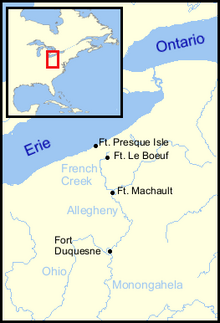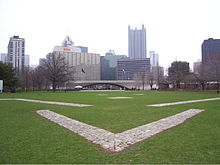Fort Duquesne
This article includes a list of general references, but it lacks sufficient corresponding inline citations. (June 2008) |
| Fort Duquesne | |
|---|---|
| Pittsburgh, Pennsylvania, U.S. | |
 Fort Duquesne in Pittsburgh | |
| Type | Fort |
| Site information | |
| Controlled by | |
| Site history | |
| Built | 1754 |
| In use | 1754–1758 |
| Battles/wars | French and Indian War |
| Designated | May 8, 1959[1] |
Fort Duquesne (
History
18th century





Fort Duquesne, built at the confluence of the Allegheny and Monongahela rivers which forms the Ohio River, was considered strategically important for controlling the Ohio Country,[2] both for settlement and for trade. The English merchant William Trent had established a highly successful trading post at the forks as early as the 1740s, to do business with a number of nearby Native American villages. Both the French and the British were keen to gain advantage in the area.
As the area was within the drainage basin of the
In the early 1750s, the French began construction of a line of forts, starting with Fort Presque Isle on Lake Erie in present-day Erie, Pennsylvania, followed by Fort Le Boeuf, about 15 miles south in present-day Waterford, Pennsylvania, and Fort Machault, on the Allegheny River in Venango County in present-day Franklin, Pennsylvania.
In late autumn 1753, Dinwiddie dispatched a young Virginia militia officer named George Washington to the area to deliver a letter to the French commander at Fort Le Boeuf, asking them to leave. Washington was also to assess French strength and intentions. After reaching Fort Le Boeuf in December, Washington was politely rebuffed by the French.
Following
Washington, who was lieutenant colonel in the newly created
The Battle of Jumonville Glen is widely considered the formal start of the French and Indian War, the North American front of the Seven Years' War.[6][7]
Washington ordered construction of
Although Fort Duquesne's location at the forks looked strong on a map—controlling the confluence of three rivers—the reality was rather different. The site was low, swampy, and prone to flooding. In addition, the position was dominated by highlands across the Monongahela River, which would allow an enemy to bombard the fort with ease. Pécaudy de Contrecœur was preparing to abandon the fort in the face of
The French held the fort successfully early in the war, turning back the
Two months later, on November 25, 1758, the Forbes Expedition under the Scotsman General John Forbes took possession Fort Duquesne after the French destroyed and abandoned the site.[8]
Present-day site
Fort Duquesne was built at the point of land of the confluence of the Allegheny and Monongahela Rivers, where they form the Ohio River. Since the late 20th century, this area of Downtown Pittsburgh has been preserved as Point State Park. The park includes a brick outline of the fort's walls, as well as outlines to mark the later Fort Pitt.
In May 2007, Thomas Kutys, an
Commemoration

On November 25, 1958, the 200th anniversary of the capture of Fort Duquesne, the
Colonel Washington is depicted on horseback in the center, while General Forbes, who was debilitated by intestinal disease, is shown lying on a stretcher. The stamp also depicts Colonel Henry Bouquet, who was second in command to the ailing Forbes, and other figures who represent the Virginia militia and provincial army.[10]
In media
Fort Duquesne is the subject of, or referenced, in:
- In 1873, Fort Duquesne is the subject of Old Fort Duquesne, a historical novel by Charles McKnight, which retells the role of Fort Duquesne during the French and Indian War.
- In 2012, Assassin's Creed III features Fort Duquesne long after the British rebuilt it. It is one of the main forts in the game that Connor has to conquer to reclaim it for the Continental Army.
- In November 2016, Fort Duquesne appeared in Episode Seven of the first season of the NBC television series Timeless.
- In 2020, Age of Empires III: Definitive Edition features Fort Duquesne being captured by the French in the beginning of the French and Indian War.
See also
- Great Britain in the Seven Years' War
- France in the Seven Years' War
- List of French forts in North America
- Battle of Fort Duquesne
Further reading
- Fort Duquesne and Fort Pitt: Early Names of Pittsburgh Streets. Daughters of the American Revolution. Pittsburgh Chapter (Pittsburgh, Pa.). 1907. p. 47. E'book
- Craig, Neville B. (1876). The Olden Time: A Monthly Publication Devoted to the Preservation of Documents and Other Authentic Information in Relation to the Early Explorations and the Settlement and Improvement of the Country Around the Head of the Ohio, Volume 1. R. Clarke & Company., E'book
References
- ^ "PHMC Historical Markers Search" (Searchable database). Pennsylvania Historical and Museum Commission. Commonwealth of Pennsylvania. Retrieved 2014-01-25.
- ^ "The Diaries of George Washington, Vol. 1", Donald Jackson, ed., Dorothy Twohig, assoc. ed. Library of Congress American Memory site
- ^ France in America, Fitzhenry & Whiteside Limited, p. 181
- ^ Washington, George (31 May 1754). Letter from George Washington to John Augustine Washington (May 31, 1754). Retrieved 18 March 2023.
- ^ Farrell, Cassandra (22 December 2021). "Joshua Fry (ca. 1700–May 31, 1754)". Encyclopedia Virginia. Retrieved 18 March 2023.
- ISBN 0-375-40642-5.
- ISBN 978-0307419187.
- ^ Withers, & Draper, 1895, p. 73
- ^ [1] Archived September 29, 2007, at the Wayback Machine
- ^ "Fort Duquesne Issue". Smithsonian National Postal Museum. Retrieved June 12, 2014.
Bibliography
- Anderson, Fred. Crucible of War: The Seven Years' War and the Fate of Empire in British North America, 1754–1766. New York: Knopf, 2000. ISBN 0-375-40642-5.
- Hunter, William A. Forts on the Pennsylvania Frontier, 1753–1758. Originally published 1960; Wennawoods reprint, 1999.
- ISBN 0-8229-4262-3.
- Withers, Alexander Scott; Draper, Lyman Copeland (1895). Chronicles of Border Warfare. Stewart & Kidd Company.
